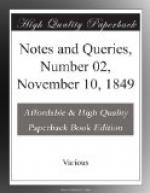MELANION.
[The work referred to by our correspondent was written by Barclay, better known as the author of the Argenis. The First Part of the Satyricon, dedicated to James the First, was published, London, 12mo. 1603; and with the addition of the 2nd Part, Paris, 1605. The best edition of the work (which, really in two parts, is made, by the addition of the Apologia Euphormionis, &c. sometimes into five) is said to be the Elzevir 12mo., 1637. There are two editions of it cum notis variorum, Leyden, 1667 and 1669, 8vo., in two volumes. Of some of the editions (as that of 1623, 12mo.) it is said, “adjecta Clavi sive obscurorum et quasi aenigmaticorum nominum, in hoc Opere passim occurrentium, dilucida explicatione.” The Satyricon was twice translated into French; and its literary history, and that of the Censura Euphormionis, and other tracts, which it called forth, might furnish a curious and amusing paper.]
* * * * *
SERMONES SANCTI CAROLI BORROMAEI.
Sir,—I have been wanting to get a sight of the following work, “Sermones Sancti Caroli Borromaei, Archiepisc. Mediol. Edidit. J.A. Saxius. 5 Tom. Mediol. 1747.” Can I learn through your columns whether the work is any where accessible in London? I sought for it in vain at the British Museum a twelvemonth ago; nor, though then placed in their list of Libri desiderati, has it yet been procured.
C. F. SECRETAN.
* * * * *
LUTHER AND ERASMUS.
Mr. Editor,—The following lines, written in a hand of the early part of the seventeenth century, occur on the fly-leaf of a copy of the {28} Translation of Luther on the Galatians, edit. London, 4to. 1577. Can any of your readers oblige me by informing me who was their author?
“Parum Lutherus ac Erasmus differunt
Serpens uterque est, plenus atro toxico;
Sed ille mordet ut cerastes in via,
Hic fraudulentus mordet in silentio.”
Your obedient servant,
ROTERODAMUS.




